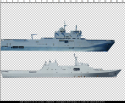Nearly 10 years after the notification of the program, the first of six new French nuclear attack submarines of the Barracuda guy should get out of Cherbourg construction hall this summer for its launching. Le Suffren then will chain dockside tests before starting its sea trials, planned a priori early 2017. Upon completion, it must be delivered to the Navy in 2018 current.
For now, DCNS teams are working hard to complete the assembly of the hull, separated into two parts, which will normally be closed next month. The National Navy, meanwhile, already constituted
Much more powerful submarines than their elders
Larger, more powerful and quieter than the six Rubis-type NLS (commissioned between 1983 and 1993) they are to replace, the Barracuda will measure 99.5 meters long and present a moving surface 4650 tons (5300 diving). Highly automated, they will be armed with a crew of 60 men (two teams will take turns as is currently the case), that will be partially feminized if the experiment conducted in 2017 on SSBNs is conclusive. As such, three female officers have also been selected and are being trained.
Equipped with a nuclear propulsion based on an evolution of the pressurized water reactor of the type K15 (50 MW) developed for the four SSBN type The Triumphant and the aircraft carrier
A varied weaponry and therefore
Their weapons, implemented in six tubes of 533 mm, may comprise up to 20 weapons with heavy F21 torpedoes, SM39 Exocet anti-ship missiles and cruise missiles (MdCN). The Barracuda will also be able to lay mines and integrate air defense against the anti-submarine warfare aircraft. This armament could consist of Mica missiles (concept A3SM DCNS) implemented via the same vehicle as the SM39 through a shot by the torpedo tubes.
Special Operations
For special operations, Barracuda will also embark behind the massive, a module housing material for the commandos. Building accommodation capacities are to the effect that 10 additional seats in addition to 60 crew members. Eventually, drones can also be integrated
Next Generation Electronics
In electronics, new French SNA will be equipped with the most modern systems (hull sonar flank antenna, towed array, mine avoidance sonar) and as the SSBN after redesign, the new combat system SYCOBS . Featuring non-penetrating optronic masts, they will be equipped with a new generation of cons-measures. This is the Nemesis, based on the Alto system DCNS, which applies a principle of 'confusion / dilution' and combines evasive maneuvers with the deployment of new Canto-S lures, built on Ruby since 2014. 60 members crew. Eventually, drones can also be integrated
Deliveries that extend until 2029
Delivery of Suffren was postponed from 2017 to 2018, a slight delay attributable in particular to the difficulties which had to overcome, as is always the case for such a complex program. However, the shift schedule that know the rest of the program is related to budgetary matters. Under construction in Cherbourg, the second type SNA Barracuda, is baptized Duguay-Trouin, should be delivered by DCNS in 2020, one year after the due date. Then, future Tourville, De Grasse, Casabianca (former Dupetit-Thouars) and Ruby (ex-Duquesne) will be completed at a rate of one unit every two years to two and a half years, with delivery of the sixth and last SNA in 2029, instead of 2027 as planned in the contract notice in December 2006.
End of remarkable career for Ruby
As for Ruby, called to be decommissioned over the entries in the service of their successors, they will have therefore reached 35 years against 25 initially planned. This, while they are in high demand on the various theaters of operation and despite the very strong activity, show a remarkable level of availability. Much higher than that experienced in other comparable marine (it would be better than 50% compared to the British Trafalgar for example), the availability rate has also been increasing for 10 years through new maintenance contracts operational condition (MCO) established between the Fleet Support Service (SSF) and DCNS. With the addition of the various successive modernizations technical maintenance (combat system, sensing, propulsion, armament, against measures ...) allowing to develop the capacity of buildings and maintain technologically upgraded, including up next Ruby decade since the last fleet will come in a dozen years
Latest IPER
Still, at DCNS, it is already preparing for the transition Barracuda, although the first Periodic Unavailability for Maintenance and Repairs Suffren is not expected before 2025/2026. While Ruby, who has known his last IPER in 2012/2013, will be the first in the series to be withdrawn from service (from 2017), only two of the six buildings of this class still benefit from a major technical stop giving them a decade potential. This is the Amethyst, currently in dry dock in Toulon and find the Navy next winter, and the Pearl, which will complete its final IPER in 2019. Meanwhile, in the second half DCNS will stop in 2017 technical intermediary (long IE) of Sapphire. Once disarmed and landed their nuclear units, the Ruby join the dismantling industry, as five former SSBN Le Redoutable type, stationed at Cherbourg.












